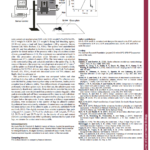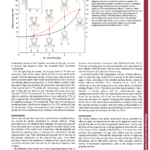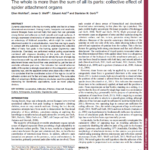Paper, The whole is more than the sum of all its parts: collective effect of spider attachment organs
Dynamic attachment is the key to moving safely and fast in a threedimensional environment. Among lizards, hexapods and arachnids, several lineages have evolved hairy foot pads that can generate strong friction and adhesion on both smooth and rough surfaces. A strongly expressed directionality of attachment structures results in an anisotropy of frictional properties, which might be crucial for attachment control. In a natural situation, more than one leg is usually in contact with the substrate. In order to understand the collective effect of hairy foot pads in the hunting spider Cupiennius salei (Arachnida, Ctenidae), we performed vertical pulling experiments combined with stepwise disabling of the pads. We found the attachment force of the spider to be not simply the sum of single leg forces because with leg pair deactivation a much greater decrease in attachment forces was found than was predicted by just the loss of available adhesive pad area. This indicates that overall adhesion ability of the spider is strongly dependent on the antagonistic work of opposing legs, and the apparent contact area plays only a minor role. It is concluded that the coordinated action of the legs is crucial for adhesion control and for fast and easy detachment. The cumulative effect of anisotropic fibrillar adhesive structures could be potentially interesting for biomimetic applications, such as novel gripping devices.
Learn about our two Decals!
 Click here to find out more about our Fall Bioinspired Design Decal and our Spring Bioinspired Design in Action Decal – ALL MAJORS are welcome.
Click here to find out more about our Fall Bioinspired Design Decal and our Spring Bioinspired Design in Action Decal – ALL MAJORS are welcome.Berkeley BioDesign Community
 Click here to learn about the BioD: Bio-Inspired Design @ Berkeley student organization or here to signup for more info.
Click here to learn about the BioD: Bio-Inspired Design @ Berkeley student organization or here to signup for more info.Search
Student Login






I imagine that the neurological circuits underlying these processes are governed by both 2d spacing maps with their brains as…
to reduce the impact of car accidents, it may be possible to study the force diverting physics of cockroaches to…
you see this type of head-bobbing stability in many avian creatures related to pigeons like chickens. the head ability to…
not like they taught horses how to run! this is an example of convergent evolution where both sea creatures and…
The brain functions in a similar way with neuronal connections. our brains are able to utilize the multiplicity of connections…